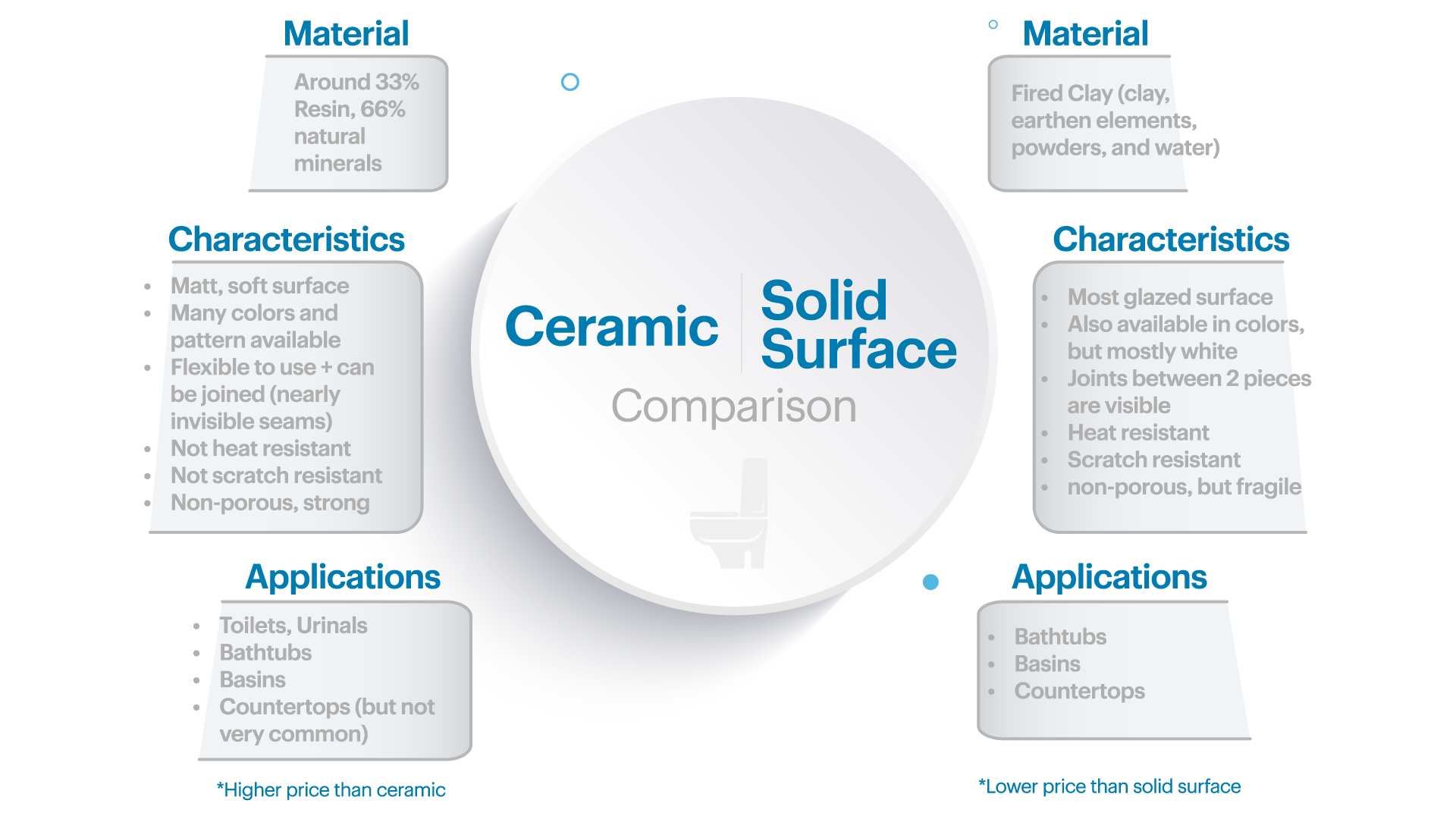When it comes to designing a bathroom, one of the most important decisions is choosing the right sanitary ware. This includes both hotel sanitary ware and public sanitary ware, which are critical for ensuring functionality and hygiene in high-traffic areas. Ceramic and solid surface materials are two popular options that offer durability, aesthetics, and functionality. In this article, we will compare ceramic and solid surface sanitary ware to help you determine which is the best choice for your bathroom. From material composition to maintenance requirements, we will explore the differences between these two options so you can make an informed decision for your next bathroom renovation project. Let's dive into the world of sanitary ware and discover which option suits your needs best.
Material Composition: Understanding the differences between ceramic and solid surface materials
Let's take a look at the materials that are being used to make ceramic and solid surface to understand the fundamental differences:
- Ceramic:
- Made from clay, minerals, and water.
- Fired at high temperatures to create a durable surface.
- Solid Surface:
- A blend of acrylic, polyester resins, and minerals.
- Formed into desired shapes through molding processes.
When it comes to material composition, ceramic sanitary ware offers a traditional yet robust option with its clay-based construction. Conversely, solid surface products provide a modern alternative by combining acrylics and resins for versatility in design possibilities.
Durability and Longevity: Which option will stand the test of time in your bathroom?
When it comes to outfitting your bathroom, durability and longevity are key factors to consider. The materials you choose for your sanitary ware will significantly impact how well your bathroom stands the test of time. Let's delve into the pros and cons of two popular options: ceramic and solid surface.
Ceramic sanitary ware has long been a go-to choice for bathrooms due to its exceptional durability. The hard, dense surface of ceramic is highly resistant to scratches, stains, and chips, making it incredibly easy to clean and maintain. With proper care, ceramic fixtures can last for decades without losing their luster or functionality. This longevity ensures that your bathroom remains stylish and functional for many years to come.
While ceramic offers unbeatable durability, solid surface sanitary ware may appeal to those seeking a more contemporary and seamless look. These fixtures are crafted from synthetic materials that can be molded into a variety of shapes and colors. However, solid surface may not be as durable as ceramic. It is more susceptible to scratches and damage, especially if exposed to harsh chemicals or abrasive cleaning agents. Over time, solid surface fixtures may show signs of wear and tear more quickly than their ceramic counterparts.
Ultimately, the choice between ceramic and solid surface sanitary ware depends on your priorities. If durability and longevity are paramount, ceramic is the clear winner. However, if aesthetics and a more modern look are your primary concerns, solid surface may be a suitable option. Carefully consider your lifestyle, cleaning habits, and long-term goals when making your decision.
Aesthetics and Design: Comparing the look and feel of ceramic and solid surface sanitary ware
When it comes to aesthetics, ceramic sanitary ware offers a classic and timeless look that is hard to beat. The glossy finish of ceramic sinks and toilets adds a touch of elegance to any bathroom. On the other hand, solid surface sanitary ware has a more modern and sleek appearance, with seamless designs that create a clean and minimalist look.
In terms of design options, ceramic sanitary ware often comes in traditional shapes and styles that are widely available on the market. Solid surface sanitary ware, on the other hand, offers more flexibility in design possibilities due to its moldable nature. This allows for custom-made pieces that can be tailored to suit individual preferences and unique bathroom layouts.
Overall, the choice between ceramic and solid surface sanitary ware ultimately depends on personal style preferences and the desired aesthetic for your bathroom space. Whether you prefer the classic elegance of ceramic or the modern versatility of solid surface materials, both options offer durability and functionality while enhancing the overall look of your bathroom.
Installation and Cost: Factors to consider when choosing between ceramic and solid surface options
Installation
Ceramic sanitary ware is typically heavier than solid surface options, which can make installation more labor-intensive. Solid surface products are lighter and easier to handle during installation, potentially reducing labor costs. However, both materials require skilled professionals for proper installation to ensure a watertight seal and longevity.
Cost
In terms of upfront cost, ceramic sanitary ware tends to be more affordable compared to solid surface options. However, it's essential to consider long-term maintenance costs as well. Ceramic may be prone to chipping or cracking over time, leading to potential repair expenses. Solid surface products are known for their durability and resistance to wear and tear, which could result in lower maintenance costs in the long run.
When deciding between ceramic and solid surface sanitary ware for your bathroom, it’s crucial to weigh the factors of installation complexity and overall cost implications. While initial costs may favor ceramic options, considering long-term maintenance expenses could sway your decision towards investing in durable solid surface solutions for a bathroom that will stand the test of time.
Maintenance Requirements: Which material is easier to clean and maintain in the long run?
When it comes to cleaning and maintenance, ceramic sanitary ware generally requires less effort than solid surface options. Ceramic surfaces are smooth and non-porous, making them easy to wipe down with a damp cloth or mild detergent. This material is also resistant to stains and scratches, ensuring that your bathroom fixtures remain looking new for longer periods of time.
On the other hand, solid surface sanitary ware may require more attention when it comes to cleaning. The porous nature of this material can make it susceptible to stains if not properly maintained. To keep solid surface sanitary ware in top condition, regular cleaning with non-abrasive cleaners is recommended. Consider your lifestyle and level of commitment to maintenance when choosing between ceramic and solid surface options for your bathroom.
- Ceramic: Easy to clean with a damp cloth or mild detergent
- Solid Surface: Requires regular cleaning with non-abrasive cleaners
Eco-Friendliness: Examining the environmental impact of ceramic and solid surface sanitary ware
- Ceramic sanitary ware typically has a lower environmental impact compared to solid surface options. The production process of ceramic involves natural materials like clay and water, making it more sustainable.
- On the other hand, solid surface sanitary ware is often manufactured using synthetic materials that may have a higher carbon footprint. Additionally, the production of solid surface materials can result in more waste being generated.
When considering eco-friendliness, choosing ceramic sanitary ware may be the better option as it is made from natural resources and has a smaller environmental footprint overall.
Customization Options: Which option offers more flexibility in terms of design and customization?
- Solid Surface Sanitary Ware: This option offers more flexibility in design and customization compared to ceramic. With solid surface materials, you can easily mold and shape the products to fit your specific bathroom layout. Additionally, these surfaces can be customized with various colors, patterns, and textures to match your desired aesthetic.
- Ceramic Sanitary Ware: While ceramic sanitary ware is durable and easy to maintain, it may offer less flexibility in terms of design customization. Ceramic pieces are typically available in a limited range of shapes and sizes, making it challenging to create unique or personalized bathroom designs using this material alone. When it comes to intricate designs or custom colors, solid surface options may be a better choice for those seeking more creative freedom in bathroom styling.
In conclusion, if you prioritize design flexibility and customization options for your bathroom renovation project, solid surface sanitary ware may be the best choice due to its versatility in shaping and coloring options.

Conclusion: Making the final decision on whether ceramic or solid surface sanitary ware is the best choice for your bathroom
After considering the pros and cons of both ceramic and solid surface sanitary ware, it is essential to weigh your priorities when making a decision for your bathroom.
- Durability: If durability is your main concern, ceramic sanitary ware may be the best option as it is known for its strength and resistance to wear and tear.
- Customization: Solid surface sanitary ware offers more flexibility in terms of design and color options, allowing you to create a unique look in your bathroom.
- Maintenance: Ceramic sanitary ware may require less maintenance over time compared to solid surface options, which may show signs of wear more easily.
Ultimately, the choice between ceramic and solid surface sanitary ware comes down to personal preference, budget considerations, and the specific needs of your household. By carefully evaluating these factors, you can make an informed decision that will ensure a stylish and functional bathroom for years to come.
PS: If you are interested in understanding where sanitary ware is made in China, we recommend you reading our article about the production hot spots in Guangdong.





